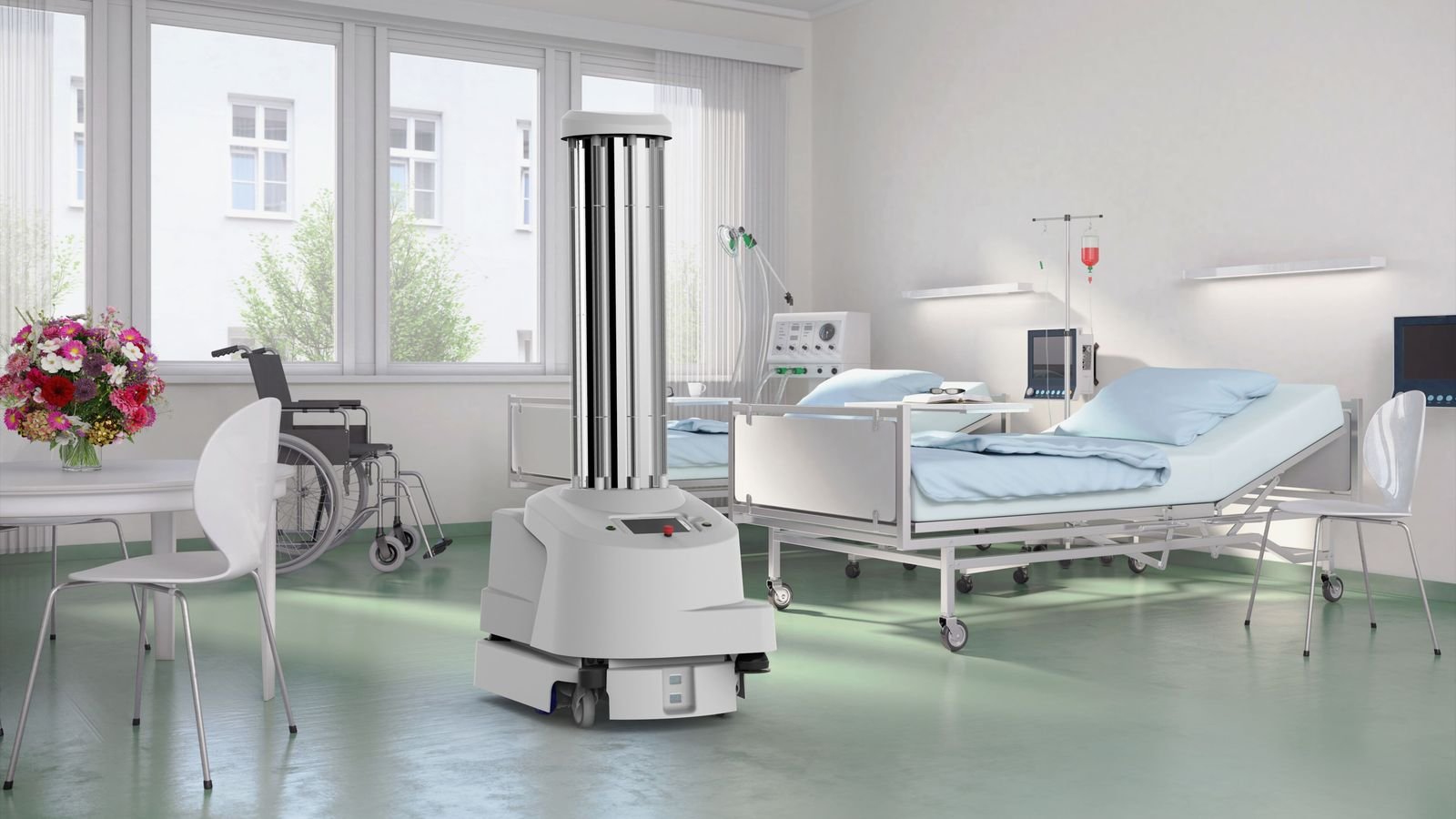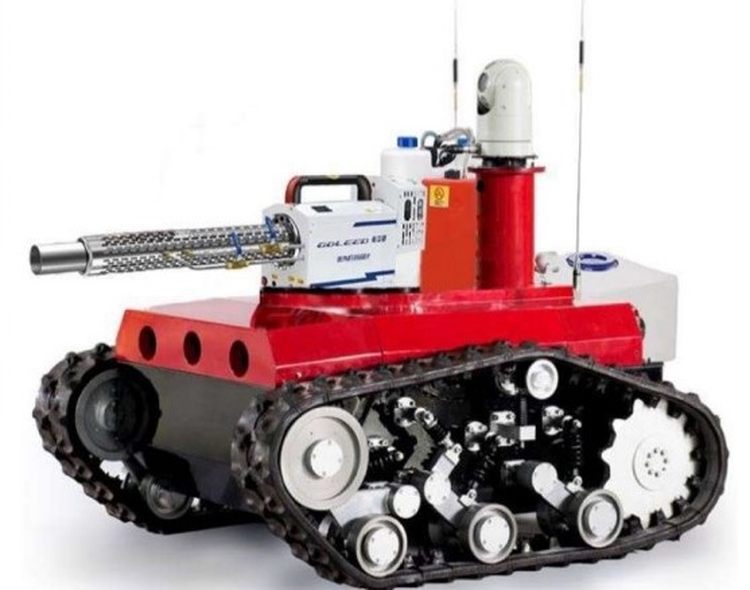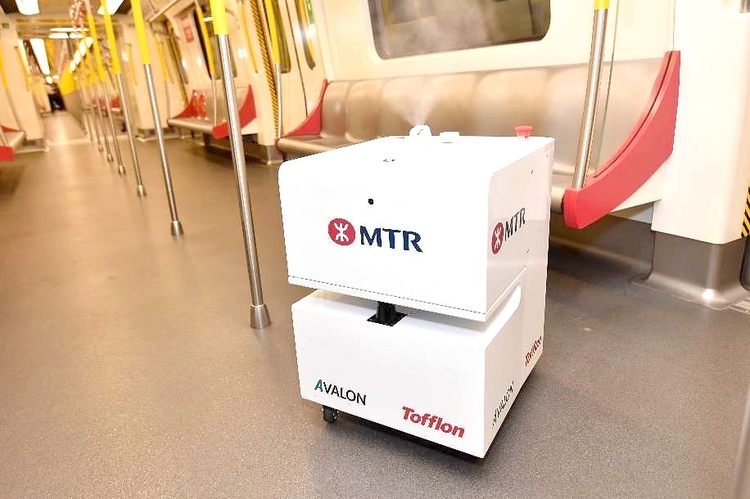
Case Studies / Service Robots / Mobile Robots / Robots addressing the UN SDGs / Robots in Daily Life / Robots and COVID-19
Cleaning robots reduce infections in hospitals and public spaces
Robots in Daily Life
Mar 09, 2021 — Sales of cleaning robots have boomed since COVID 19, helping keep patients and staff safe. Cleaning robots are also used in public spaces such as hotels and public transport.
“UVD Robot” by Blue Ocean Robotics drives autonomously and eliminates bacteria and other harmful microorganisms in hospitals © Blue Ocean Robotics
Infections caught during hospital stays account for around 37 000 deaths per year in Europe and almost 100,000 in the U.S. The cost of treating hospital infections runs to around €7 billion in Europe and US$6.5 billion in the U.S. Ultra-violet disinfection robots can destroy 99.9% of all microorganisms in a hospital room within 10 minutes. While the room must be empty during disinfection, there are no negative effects of the UV rays. These robots do not replace cleaning staff, who are still required to remove ‘hard’ stains such as blood and urine.
The coronavirus pandemic has rapidly accelerated the adoption of disinfection robots and expanded their use from hospitals to hotels and public spaces such as airports and public transport. However, the increase in infections resistant to antibiotics is also spurring a focus on the prevention of infection, particularly in hospitals. Drug-resistant diseases cause at least 700,000 deaths a year according to the World Health Organisation, which estimates this figure could increase to 10 million deaths globally per year by 2050.
Sales of professional cleaning robots increased by 20% to 55 million in 2019 over the previous year and the IFR expects this to be a booming market as a result of the COVID19 pandemic (IFR World Robotics 2020: Service Robots). Disinfection robots are provided by a wide range of suppliers and vary in design. Danish company Blue Ocean Robotics, won the 2019 IERA innovation award from IEEE and IFR and the Frost & Sullivan 2020 European Professional Service Robots Product Leadership award for its UVD disinfection robot, which moves autonomously around hospitals emitting UV-C light. The robot stops emitting if there is unexpected movement which would indicate a person entering the room. The robot uses LIDAR sensors to create a map of its environment which can then be marked up by an operator to show which rooms and other areas should or should not be disinfected. The robot then navigates autonomously around the hospital.
The TMiRob from Chinese company Taimi Robotics Technology provides three types of disinfection; UV, hydrogen peroxide and plasma air filtration which can be used separately or together depending on disinfection needs. UV-C, for example, cannot travel through objects and therefore cannot clean surfaces blocked from line-of-sight by other objects whereas hydrogen peroxide misting is very effective for full surface cover, but takes longer and requires more intensive preparation, such as removing absorbent material and sealing ventilation points.

Siemens Aucma disinfection robot © Siemens
While most disinfection robots move on small-wheeled bases, a number of companies such as Indian robot manufacturer Milagrow, and Siemens together with its Chinese partner Aucma, have developed disinfection robots that run on caterpillar tracks to expand the robot’s scope of operation to include steep slopes and uneven surfaces.
Robots are also being used to make hotels and public spaces safer for people during the COVID-19 pandemic. Not only are they used for cleaning, they are also being used to minimize human contact, for example providing room service deliveries in hotels.

Robot disinfecting the Hong Kong metro © MTR Corporation
A number of transportation companies are using cleaning robots. For example, Hong Kong transportation company MTR Corporation has deployed a Vapourised Hydrogen Peroxide Robot (VHP Robot) to clean train compartments and stations. The robot, developed by MTR and Avalon Biomedical sprays atomised hydrogen peroxide which penetrates small gaps that normal cleaning methods cannot reach. The robot can be operated remotely through a pre-programmed floor plan or it can be operated manually. East Japan Railway has used cleaning robots at major stations for some time. Pittsburgh (US), Hong Kong, Singapore, Heathrow (UK) and Narita International (Japan) are among the airports using cleaning robots. Pittsburgh airport has retro-fitted its existing floor-cleaning robots with UV fixtures, collaborating with Carnegie Robotics.
A number of hotel chains including Hilton, Intercontinental, Marriot and Waldorf Astoria are using robots for room cleaning and / or to make room service deliveries. Most hotels use robots to disinfect rooms using UV light following the regular clean by staff. Robot butlers feature a mobile robot base with a secure storage box. The ordered items are loaded into the storage box and the robot is then dispatched. These robots are able to navigate their way autonomously through the hotel – including using lifts - using an inbuilt map and real-time sensor data. Guests enter a PIN on the storage box to access their items. A number of hotels in Tokyo, Japan, used to house mildly ill coronavirus patients in an effort to unburden Tokyo hospitals, have used robots to greet guests and clean areas used by guests to pick up food and other necessities.

ADLATUS CR700 is an autonomous professional cleaning robot. It addresses logistic centers, supermarkets, public transport and industrial surfaces © ADLATUS robotics GmbH
A number of food retailers and mall operators are trialling or using cleaning robots. Amazon has tested a UV robot in its Whole Foods Markets, for example, while various shopping malls in Singapore use PBA Group’s ‘Sunburst UV Robot’ (which is also deployed in hospitals in Malaysia and Singapore).
Video Examples on YouTube



